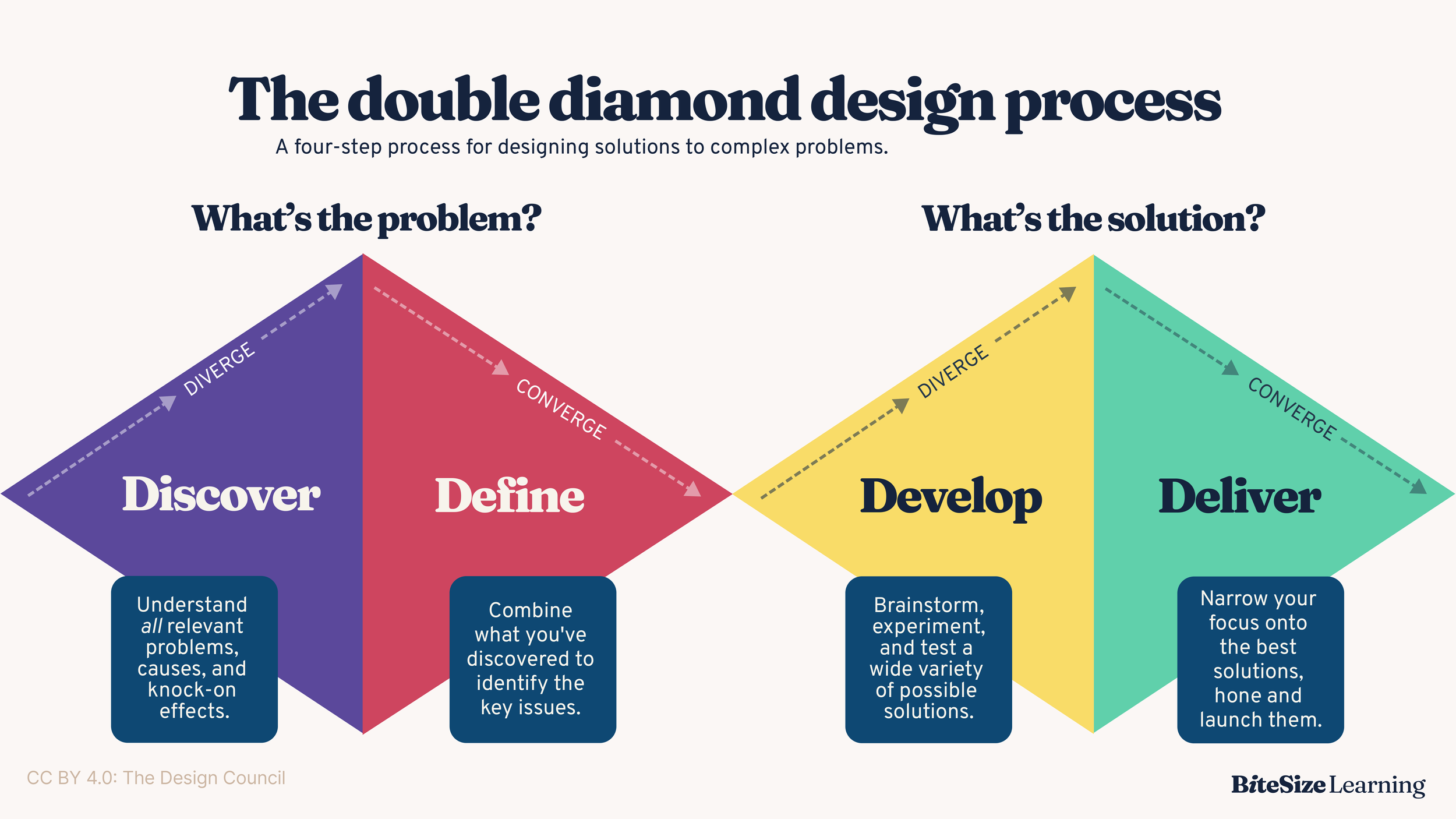Design solutions to problems with the Double Diamond process
Library → Models and frameworks → Double Diamond design thinking process
A design framework developed by the Design Council in 2003, the double diamond process is a powerful framework for any person or team devising creative solutions to complex problems.
A classic model of ‘design thinking’, this process isn’t only suitable for dreaming up new products or creating a new website. Any challenge you might face at work, from a workflow snag to collaborative tensions, requires a solution – and every solution needs ‘designing.’ And stands to reason that designing can benefit from a structured approach like the Double Diamond.
Best of all, the format can be applied to problem-solving activities as brief as a single meeting – or as long as a major year-long enterprise. By implementing a format like the Double Diamond and educating others on the framework, you can:
Draw on people’s strengths at the right time: you might manage involvement in the process according to the team role or social style of each team member. Some free-thinking spirits may thrive in the generative phases of divergent thinking, whereas more analytical & practical types will come to the fore when it’s time to scrutinise and prioritise.
Ensure diverse thinking: a legible process makes it clear when it’s time to seek out ideas and information, and when the time has come to cook with whatever’s already in the pot. This can reassure the feasibility-minded that the blue-sky thinking will eventually end, prevent fragile ideas getting shot down early during brainstorms, and also rein in the perpetually-curious and analysis-paralysed when it’s time to focus.
Solve the right problem: rather than rushing off to solve the immediately obvious problem, the Double Diamond process encourages a period of exploration and discovery to ensure your efforts are targeted optimally at the root cause of the issue.
Create checkpoints for stakeholders: the straightforward four-phase design creates natural moments to communicate with influential people on your stakeholder map, to garner additional input and support.
Let’s take a look.
The double diamond design process, explained
Stick or twist. All-in or fold. Explore or exploit. Inhale or exhale. Open up or hunker down.
Our language is full of dualities, and the Double Diamond is no exception. It recognises the importance of two key modes of problem solving:
divergent thinking, where we’re gathering more information, generating more ideas and thinking big
convergent thinking, where we’re editing down, making tough choices, and driving towards an answer.
The Double Diamond applies a ‘divergent’ and ‘convergent’ phase to two distinct parts of the design process: understanding the problem, and developing a solution.
Things gone pair-shaped? Double diamonds are a problem-solver’s best friend.
1) Discover all you can about the underlying problems
The Discovery phase is all about building a deeper understanding of the problem that your team is looking to solve.
It's a fact-finding mission, an exploration. You aren't solving the problem just yet — you're simply trying to grasp its scale, its complexity, and its underlying context.
For a major project, or an initiative broad in scope (like ‘how can my team have the biggest impact next year?’) the discovery phase could last weeks or months, involve elements like surveys, interviews, data analysis, and other desk research.
But even within an hour-long brainstorm meeting, you should still carve out time to ‘Discover’ and ‘Define’ before you rush into dreaming up solutions.
Think big and look deeper: this phase is most productive when tackling a broad question. For instance, let’s say the lease on your office is ending, and you’ve been tasked with ‘finding a new office.’ Notice that in this scenario, you’ve dropped directly in the ‘develop’ phase, immediately seeking potential solutions to a ‘simple’ problem. Instead, consider zoom out and ask ‘why do we need an office?’, which might then reveal the deeper question of ‘how might we best support our people in working deeply and collaborating productively?’ Investigating this question during the discovery phase could lead to more creative solutions later on.
Don’t frame questions in terms of possible solutions: If you ask people straight-up which ‘X’ they prefer, don’t be surprised if you end up with a lot of types of X. If you want to discover surprising Y and Z solutions, ask instead about their needs, behaviours, feelings and routines. Asking what people want is no match for understanding why they want it.
2) Define the main problems you’ll try to solve
The definition phase of the Double Diamond design process is about distilling all the information, data, and insights you gathered in the Discover phase down into a clear, concise problem statement.
This is a ‘convergent’ phase where you're going from broad understanding to specific focus. It's the point where the team aligns on exactly what problem they're trying to solve, so you’re ready to move out of ‘understanding the problem’ and ready to start dreaming up a solution. Exciting!
Synthesise the data: After the discovery phase, you're likely sitting on a mountain of information. In the define phase, it's your job to make sense of this data. Review the data, discuss it with your team, and try to connect the dots. This will likely involve sorting through your findings, categorising them, and finding commonalities.
Look for tensions and correlations: Perhaps ‘improvement’ in one area actually causes problems in another. Or perhaps X only goes wrong when Y hasn’t worked properly. Do the issues you’ve discovered seem to have common causes or are they perhaps negatively correlated?
Look for chains of cause, effect and impact: As well as the superficial problems you might have identified, consider their causes, and the causes of those causes. (This is sometimes called doing the ‘Five Whys.’) Likewise, investigate the knock-on-effects of your problems. What happens after they happen? How bad as it? A simple impact vs. effort matrix might help you identify the problems that, if fixed, provide the most leverage.
Communicate your findings: By the end of this process, you should be able to concisely explain the most important problem or problems you are trying to design a solution to. You should be able to tie these to genuine insights and data points from your Discovery Phase, so that stakeholders understand why they’ve been chosen. This is also the time to explicitly de-prioritise other issues that emerged but were not prioritised, so that others don’t get distracted by them.
Your final problem statement is what you’ll test solutions against in the next phase.
3) Develop a long-list of possible solutions
The development phase of the Double Diamond design process is where creativity really comes into play. It's about brainstorming, ideation, and exploring a multitude of potential solutions.
Like ‘Discover’, it’s another highly-generative ‘divergent’ phase where more is more. But rather than ‘finding all the problems’, this is about ‘inventing tons of solutions to just a couple of problems.’ The 'Develop' phase is about exploring, experimenting, and refining. It's a creative, dynamic process, full of trial and error. The goal is to end with a solid set of potential solutions, ready to be tested and implemented in the 'Deliver' phase.
Brainstorm: This is where you generate as many ideas as possible. The aim here is quantity over quality. Encourage wild and out-of-the-box thinking. At this stage, no idea is too far-fetched or silly. A tool like mind-mapping can be very helpful. Remember, it's about breadth, not depth.
Encourage diversity: Just as in the Discover phase, diversity of thought is critical. Involve people from different parts of the organisation, with different expertise and perspectives. This will give you a richer pool of ideas and potential solutions.
Prototype and experiment: As ideas start to solidify, create low-fidelity prototypes and test them. These can be sketches, storyboards, or anything that helps visualise and communicate the idea. You're trying to bring ideas to life in a tangible way, even if it's in a rough format.
Gather feedback: Test your prototypes with end users, stakeholders, or anyone who can provide valuable feedback. You're looking to learn how well your ideas work, where they fall short, and how they might be improved. The key here is to fail fast and iterate. You want to learn and adapt quickly.
Refine and select: Based on the feedback, refine your ideas and prototypes. You might find that some ideas merge, some diverge, and some are discarded entirely. This is a process of selection and refinement. You're gradually moving towards a smaller set of strong, well-defined solutions.
Prepare for implementation: As the Develop phase comes to a close, you should have a clear idea of which solutions you want to carry forward into the final Deliver phase. Make sure these are well-documented, clearly communicated, and ready for the next steps.
4) Deliver the best solution through an iterative process
The delivery phase is where your ideas become reality.
You've explored the problem, defined it clearly, and developed a range of potential solutions. Now, it's time to refine those solutions, test them more rigorously, and prepare for implementation.
Here's how to navigate this phase:
Optimise your solutions: At this stage, you should have a handful of potential solutions from the Develop phase. Now it's time to finalize these. This might mean creating high-fidelity prototypes, detailed plans, or even a minimum viable product (MVP).
Conduct rigorous testing: With your finalized solutions in hand, it's time for rigorous testing. This means putting your solutions in the hands of end-users, gathering their feedback, and seeing how your solutions perform in real-world conditions. You want to uncover any issues or weaknesses before full-scale implementation.
Iterate and improve: Based on the feedback from your testing, you'll likely need to make adjustments. This could mean tweaking a feature, changing a process, or even going back to the drawing board for certain aspects. Remember, design is an iterative process. Each round of feedback and improvement gets you closer to an effective solution.
Prepare for launch: With testing and iterations complete, it's time to prepare for launch. This could mean planning for production, coordinating with different departments, or developing a launch plan.
Implement: Now it's time to put your solution into action. This could be launching a new product, implementing a new process, or starting a new initiative. You've done the work; now it's time to see the results.
Evaluate post-implementation: The design process doesn't stop at implementation. After your solution is live, it's important to continue monitoring and evaluating its effectiveness. Are users responding positively? Is it solving the problem as intended? What unforeseen issues have arisen? Use this information to make ongoing adjustments and improvements.
Remember, the 'Deliver' phase is about bringing your ideas to life and seeing them in action. It's the culmination of all your work in the Discover, Define, and Develop phases. But it's not the end of the process — successful design requires ongoing monitoring, evaluation, and iteration. Keep learning, keep improving, and keep striving to solve the problem at hand.
The double diamond process: summary table
| Discover | Define | Develop | Deliver | |
| Description | Understand the problem through broad research and data gathering. | Distill insights from the Discover phase into a clear and concise problem statement. | Generate a wide range of ideas and develop them into potential solutions. | Finalize, test, and implement the solution. |
| Methods | Interviews, Surveys, Observation, Desk Research | Data Analysis, Stakeholder Discussion, Creating Personas, Crafting Problem Statement | Brainstorming, Prototyping, User Testing | Prototyping, User Testing, Implementation, Post-Implementation Evaluation |
| Do | Remain open and curious, Involve diverse perspectives, Document findings | Align the team, Synthesize data effectively, Form deep insights | Encourage creativity, Embrace failure as learning, Refine based on feedback | Test rigorously, Prepare for implementation, Evaluate post-implementation |
| Don't | Don't rush to conclusions, Don't ignore contradicting information | Don't leave out crucial data, Don't overlook the importance of team agreement | Don't limit the ideation process, Don't forget to test with end-users | Don't skip the testing phase, Don't stop improving post-implementation |
Example: designing a learning & development strategy using a double diamond process
Discover: Emma, a new L&D professional at an international financial institution, wanted to take the company's learning and development strategy to the next level. However, before she could map out a plan, she needed to better understand the current L&D landscape, its successes, and its shortcomings.
To achieve this, she dove into the 'Discover' phase of the Double Diamond process. Emma and her team gathered information from various sources across the organization: They scrutinized exit interview data, studied the feedback from 360-degree performance reviews, and combed through results from employee engagement surveys. They conducted interviews with managers and team leads, and even invited input from senior leadership. They also studied data on industry best practices, trends in corporate learning, and cutting-edge L&D research.
Define: Armed with a wealth of data, Emma and her team began the 'Define' phase. They noticed certain patterns emerging: Employees sought more practical, hands-on training; managers reported a lack of leadership development opportunities; and there was a consistent demand for better resources to support continuous learning and upskilling.
From this data, they distilled their problem statement: "Our current L&D strategy does not sufficiently provide practical, hands-on training, lacks focus on leadership development, and misses opportunities for continuous learning and upskilling.
Develop: With the problem clearly outlined, the team launched the 'Develop' phase. They brainstormed a wide range of potential solutions to address the identified shortcomings. Ideas included setting up a mentorship program, designing leadership development workshops, introducing e-learning modules for continuous upskilling, and incorporating live training sessions delivered by an external agency.
The team developed prototypes for these solutions: a framework for the mentorship program, an outline for leadership development workshops, a sample module for an e-learning platform, and a proposal for partnering with an external agency specializing in corporate training.
These prototypes were tested through focus groups, pilot programs, and feedback sessions, leading to iterations and refinements based on the responses they received.
Deliver: The 'Develop' phase led to the creation of a multi-pronged L&D strategy, which included a mentorship program, leadership development workshops, an e-learning platform, and regular live training sessions delivered by an external agency.
Emma's team finalized these solutions, creating comprehensive plans and high-fidelity prototypes. They received buy-in from senior leadership and prepared for implementation.
The new L&D strategy was implemented in stages, with Emma's team closely monitoring each rollout. They sought regular feedback from participants, managers, and the external agency, and continued to refine and improve the programs based on this feedback.
By applying the Double Diamond design process, Emma's team was able to develop a comprehensive and effective L&D strategy that addressed the organization's needs, leading to improved training outcomes, better leadership development, and increased employee engagement.











